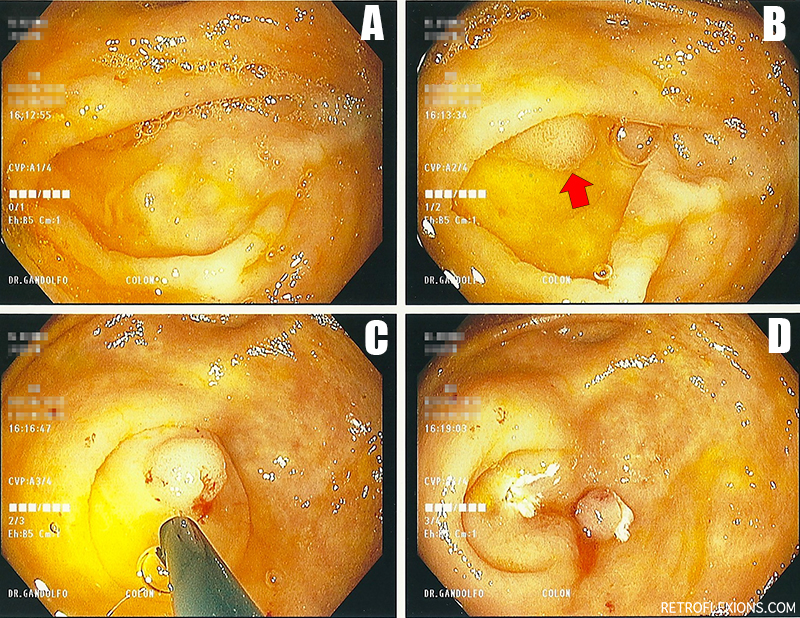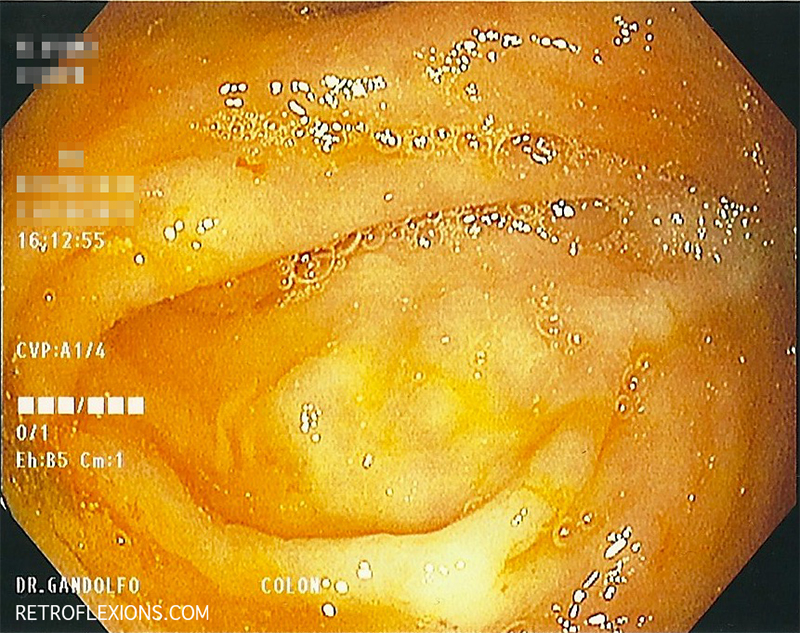If you are just joining us now, March is colorectal cancer awareness month, and we have already covered a good chunk of the colon cancer screening guidelines over the last three weeks. If you want to catch up, you can find those articles here (you can go ahead and read them…I’ll wait):
- When to start colorectal cancer screening?
- How often do you need to repeat a negative colonoscopy?
- When do you stop screening for colorectal cancer?
Ok, now that you’re all caught up, I thought it would be a good time to show a real-life example of colorectal cancer prevention in action. Let’s pretend that you are a friendly neighborhood gastroenterologist, just minding your own business and doing a screening colonoscopy on a patient. You reach the end of the colon and snap that important picture of the appendiceal orifice. Sweet! Now it’s time to withdraw the scope, and–wait a minute…what is that?
Did you see it? No? Here, what about now?
There is a sneaky little polyp just barely sticking out of the appendiceal orifice! Your patient is unconscious right now from all that wonderful propofol, but if he were awake he would be relieved to know that by finding that little polyp you may have just prevented him from developing colon cancer several year from now! Now it is time for the fun part…please go ahead and remove that polyp.
What do you mean you don’t know how? Haven’t you been reading this site? Just use the snare thingy! No, not that thing, the other thing. Not that other thing….the round thing! Alright, forget it! Just let me show you…

A: original appearance; B: red arrow shows polyp; C: saline is injected to raise the polyp out of the appendiceal orifice (important to note that the entire polyp is visible and none is hidden inside the appendiceal orifice after lifting); D: after a hot snare is used to resect the polyp (note the white cauterized base of the polyp site, and the resected polyp sitting nearby). Pathology revealed a tubular adenoma.
Well, that was a fun little role-playing exercise, but let’s get serious for a minute. By having this screening colonoscopy and removing that polyp, this patient just cut down his risk of developing colon cancer dramatically. Here are all the steps that it took to get to this point:
- The patient, a family member, or his primary care doctor realized that screening for colorectal cancer was a good idea once he turned 50 years old.
- The patient took the initiative to make the call and schedule an appointment with a gastroenterologist.
- The gastroenterologist evaluated the patient, and educated him about the procedure and the bowel prep.
- An actual appointment was booked for the colonoscopy.
- The patient followed the doctor’s instructions regarding diet and bowel prep and did an excellent job “cleaning out” because he knew that a quality colonoscopy depends heavily on the quality of the bowel prep.
- The patient shows up on the appointment date! (This step is very important.)
- The gastroenterologist practices the proper inspection technique necessary to find small and hidden polyps (and knows that he/she is doing a good job by making sure that his/her adenoma detection rate is at least 25%).
- The gastroenterologist practices the proper polypectomy technique to remove the polyp completely and not leave residual tissue behind that could continue to grow into cancer.
Now that this polyp has been removed, what do we do with this patient in the future? When does he need a follow up colonoscopy? Remember, he is no longer in the screening population anymore, since once a precancerous polyp is found, the next colonoscopy is done for surveillance. Well it just happens that this question makes an excellent segue into next weeks topic, so stay tuned!
If you enjoyed this article, sign up for our free newsletter and never miss a post!

